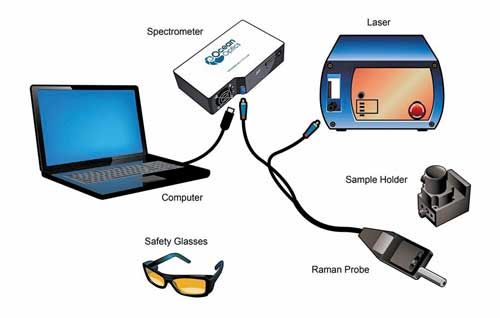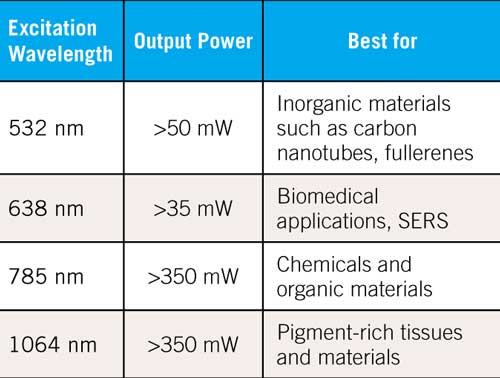Tech Tip: Choosing Raman Excitation Wavelengths
Special Issues
Raman spectroscopy offers a number of benefits for testing and characterization, with the selection of system components and measurement parameters offering great flexibility.

Raman spectroscopy offers a number of benefits for testing and characterization, with the selection of system components and measurement parameters offering great flexibility. In this technical tip, we’ll focus on the choice of Raman laser excitation wavelength.
Raman scattering requires a very high intensity light source or long spectral acquisition times in order to generate enough photons for detection. The source should also be monochromatic to interrogate the narrowest Raman features and with the greatest resolution. Since the amount of Raman scattering is proportional to the intensity of the light source, lasers are a natural choice, particularly as they can be focused very precisely into a small sample or through a window.
Raman signal is proportional to 1/λ4 of the excitation wavelength. While this makes it tempting to use a short wavelength laser, autofluorescence generated in the sample can easily degrade signal-to-noise and make Raman peaks difficult to resolve. Organic samples are particularly prone to autofluorescence, driving excitation to red or NIR wavelengths (660â830 nm). The effect is much less pronounced for inorganic materials, including carbon nanotubes and fullerenes, more commonly studied with 532 nm laser excitation.

Figure 1: Modular Raman systems begin with the choice of excitation laser and offer flexibility in measuring different materials.
Excitation at 1064 nm virtually eliminates autofluorescence, but also reduces the Raman signal significantly, further complicated by the reduced sensitivity of NIR spectrometers. UV excitation is also tempting, as the full Raman fingerprint region can be collected prior to the onset of autofluorescence at ~330 nm, but again technical limitations prevail-UV lasers and filters are more expensive and lower performance, while the high energy of UV light can damage samples quickly during measurement.

Raman Excitation Laser Options
Raman spectroscopy requires laser sources with spectral purity and wavelength stability. Our Raman lasers use an innovative stabilization technology that provides extremely narrow wavelengths that remain locked at the desired excitation wavelength regardless of ambient temperature changes. These high-power excitation sources combine integrated laser drivers and thermoelectric coolers in a compact footprint. Lasers are available for various excitation wavelengths and can be used as turnkey (with built-in laser drivers and thermoelectric cooling) or integrated (designed for use in OEM systems) packages.
Ocean Optics
830 Douglas Avenue, Dunedin, FL 34698
tel. (727) 733-2447, fax (727) 733-3962
Website: www.OceanOptics.com
